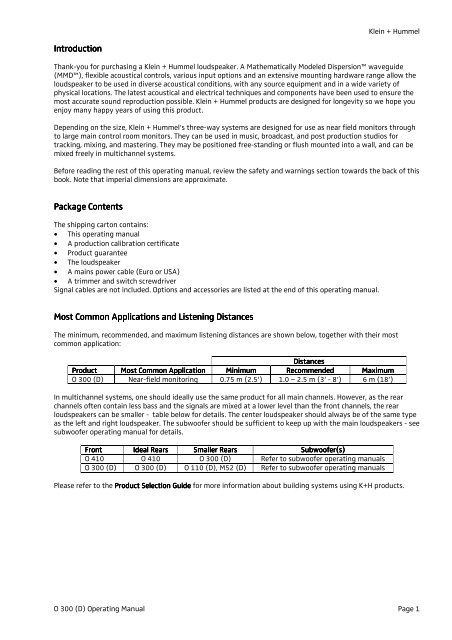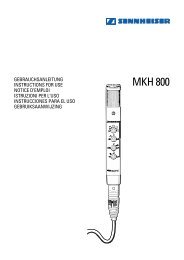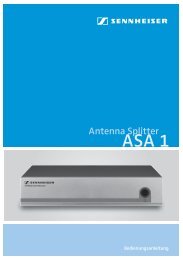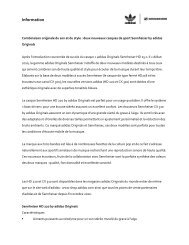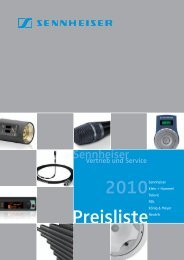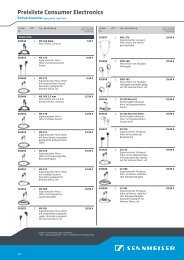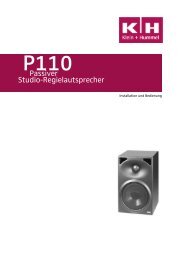O 300 (D) Operating Manual v01 - Klein + Hummel
O 300 (D) Operating Manual v01 - Klein + Hummel
O 300 (D) Operating Manual v01 - Klein + Hummel
Create successful ePaper yourself
Turn your PDF publications into a flip-book with our unique Google optimized e-Paper software.
<strong>Klein</strong> + <strong>Hummel</strong><br />
Introduction<br />
Thank-you for purchasing a <strong>Klein</strong> + <strong>Hummel</strong> loudspeaker. A Mathematically Modeled Dispersion waveguide<br />
(MMD), flexible acoustical controls, various input options and an extensive mounting hardware range allow the<br />
loudspeaker to be used in diverse acoustical conditions, with any source equipment and in a wide variety of<br />
physical locations. The latest acoustical and electrical techniques and components have been used to ensure the<br />
most accurate sound reproduction possible. <strong>Klein</strong> + <strong>Hummel</strong> products are designed for longevity so we hope you<br />
enjoy many happy years of using this product.<br />
Depending on the size, <strong>Klein</strong> + <strong>Hummel</strong>’s three-way systems are designed for use as near field monitors through<br />
to large main control room monitors. They can be used in music, broadcast, and post production studios for<br />
tracking, mixing, and mastering. They may be positioned free-standing or flush mounted into a wall, and can be<br />
mixed freely in multichannel systems.<br />
Before reading the rest of this operating manual, review the safety and warnings section towards the back of this<br />
book. Note that imperial dimensions are approximate.<br />
Package Contents<br />
The shipping carton contains:<br />
• This operating manual<br />
• A production calibration certificate<br />
• Product guarantee<br />
• The loudspeaker<br />
• A mains power cable (Euro or USA)<br />
• A trimmer and switch screwdriver<br />
Signal cables are not included. Options and accessories are listed at the end of this operating manual.<br />
Most Common Applications and Listening Distances<br />
The minimum, recommended, and maximum listening distances are shown below, together with their most<br />
common application:<br />
Distances<br />
Product<br />
Most t Common Application<br />
Minimum<br />
Recommended<br />
Maximum<br />
O <strong>300</strong> (D) Near-field monitoring 0.75 m (2.5’) 1.0 – 2.5 m (3’ - 8‘) 6 m (18’)<br />
In multichannel systems, one should ideally use the same product for all main channels. However, as the rear<br />
channels often contain less bass and the signals are mixed at a lower level than the front channels, the rear<br />
loudspeakers can be smaller - table below for details. The center loudspeaker should always be of the same type<br />
as the left and right loudspeaker. The subwoofer should be sufficient to keep up with the main loudspeakers - see<br />
subwoofer operating manual for details.<br />
Front<br />
Ideal Rears<br />
Smaller Rears<br />
Subwoofer(s)<br />
O 410 O 410 O <strong>300</strong> (D) Refer to subwoofer operating manuals<br />
O <strong>300</strong> (D) O <strong>300</strong> (D) O 110 (D), M52 (D) Refer to subwoofer operating manuals<br />
Please refer to the Product Selection Guide for more information about building systems using K+H products.<br />
O <strong>300</strong> (D) <strong>Operating</strong> <strong>Manual</strong> Page 1


